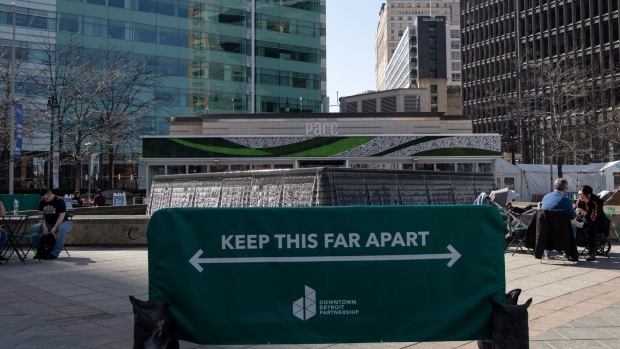Oct 25, 2022
Fear of Catching Covid Has Cost US Economy $250 Billion This Year
, Bloomberg News

(Bloomberg) -- Persistent worries about catching Covid kept about 3 million Americans out of the workforce, reducing the nation’s economic output by $250 billion in the first half of 2022, according to new research on a phenomenon dubbed “Long Social Distancing.”
Close to 60% of respondents to a monthly survey of tens of thousands of adults said they wouldn’t completely return to pre-Covid activities like riding crowded subways and elevators, and were staying out of the labor force as a result. Those not working or looking for a job in part due to infection fears totaled about 2% of the labor force, which translated to the 3 million figure, the researchers found.
When accounting for the earnings of those people, the effect equates to an annual loss in gross domestic product of about $250 billion at current prices, the report said. “People with a cautious bent or with underlying health conditions that place them at higher risk of death or serious illness from COVID-19 can find sound, understandable reasons to continue and even intensify their social distancing practices,” according to the paper’s authors, including Stanford University’s Nick Bloom. “Long Social Distancing and its effects are likely to persist for many months or years.”
While many Americans have largely moved on from the pandemic, its long-term economic and societal impacts remain profound, particularly for the millions who struggle to completely recover from Covid-19. Long Covid symptoms range from pulmonary and cardiovascular problems to cognitive issues such as so-called brain fog, and no single diagnosis or treatment applies. As many as four million Americans have dropped out of the workforce due to long Covid, according to a Brookings Institute report, and Harvard University economist David Cutler pegs the total cost of long Covid at $3.7 trillion.
Some of the long-term social distancers likely overlap with those suffering from long Covid, but the paper’s authors — which also include Steven Davis at the University of Chicago and Jose Maria Barrero of Mexico’s ITAM business school — say it’s hard to disentangle the two groups. Long social distancing is more common among those who are older, female, earn less and don’t have as much formal education, the paper found. It’s also more common when opportunities for remote work are less prevalent.
Among those not in the labor force in September, 452,000 were prevented from looking for work due to the pandemic, according to the government's latest employment report. That's down from 610,000 in June and 9.7 million people in May 2020.
Read more: What Experts Know About ‘Long Covid’ and Who Gets It
“Those who haven’t been infected but have seen a close friend or relative get hospitalized, get long Covid or have other bad outcomes are most likely to say they will be cautious in the future,” Barrero said by email. There are many other factors that affect the size of the 165 million-person US labor force, Barrero added, such as an aging population and lower levels of immigration since 2020.
Nearly 100 million cases and 1 million Covid deaths have been reported in the US. The latest variants can dodge the new booster vaccines that were designed for earlier forms of the virus, and which few Americans have received. Beyond the coronavirus, seasonal flu cases are also rising in many states including New York, where health officials have said that flu is already widespread. Most workplaces have also rolled back Covid safety protocols and vaccine mandates.
A separate survey of more than 700 employers from consultant Mercer found that many organizations are still feeling the pandemic’s effects, with absences and disabilities remaining an issue, particularly for large organizations. Leaves of absence related to long Covid were cited as a concern among 14% of those surveyed.
©2022 Bloomberg L.P.


